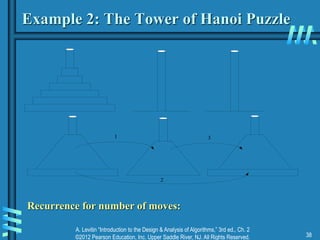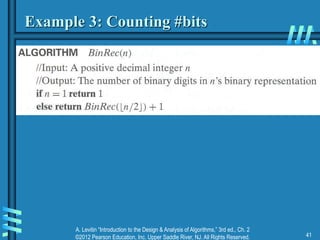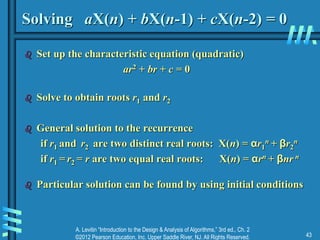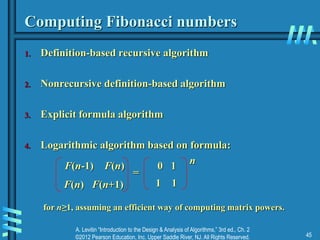This document discusses algorithm analysis and the theoretical analysis of time efficiency. It covers key issues like correctness, time efficiency, and optimality. The time efficiency of an algorithm is analyzed by determining how many times the basic operation is executed as a function of the input size. The document also discusses empirical analysis and the differences between best-case, average-case, and worst-case analyses. Finally, it introduces asymptotic analysis and the use of Big O, Big Omega, and Big Theta notation to classify algorithms by their order of growth.
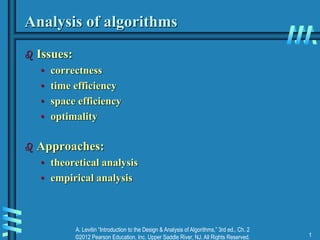
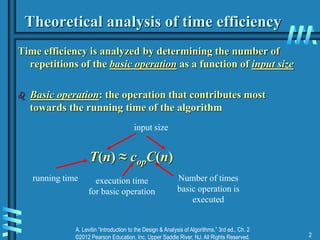


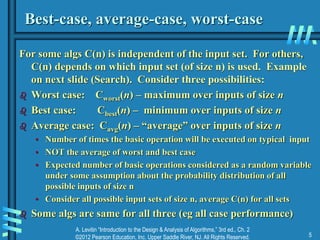

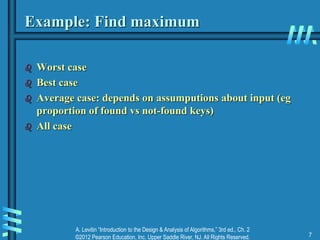
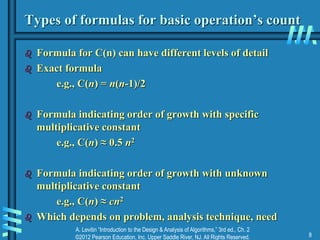




![A. Levitin “Introduction to the Design & Analysis of Algorithms,” 3rd ed., Ch. 2
©2012 Pearson Education, Inc. Upper Saddle River, NJ. All Rights Reserved. 13
Order of growth: Upper, tight, lower bounds
More formally:
- Θ(g(n)): class of functions f(n) that grow at same rate as g(n)
Upper, tight, and lower bounds on performance:
O(g(n)): class of functions f(n) that grow no faster than g(n)
• [ie f ’s speed is same as or faster than g, f bounded above by g]
Θ(g(n)): class of functions f(n) that grow at same rate as g(n)
Ω(g(n)): class of functions f(n) that grow at least as fast as g(n)
• [ie f ’s speed is same as or slower than g, f bounded below by g]](https://image.slidesharecdn.com/5261506-230719154019-083db6c6/85/5261506-ppt-13-320.jpg)






![A. Levitin “Introduction to the Design & Analysis of Algorithms,” 3rd ed., Ch. 2
©2012 Pearson Education, Inc. Upper Saddle River, NJ. All Rights Reserved. 20
Using the Definition: Big O
Informal Definition: f(n) is in O(g(n)) if order of growth of
f(n) ≤ order of growth of g(n) (within constant multiple),
Definition: f(n) O(g(n)) iff there exist positive constant c
and non-negative integer n0 such that
f(n) ≤ c g(n) for every n ≥ n0
Examples:
10n is O(n2)
• [Can choose c and n0. Solve for 2 different c’s]
5n + 20 is O(n) [Solve for c and n0]](https://image.slidesharecdn.com/5261506-230719154019-083db6c6/85/5261506-ppt-20-320.jpg)





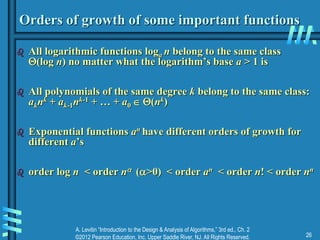





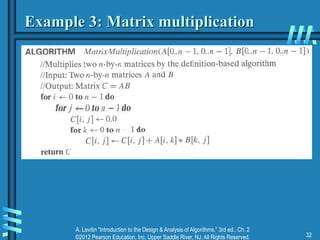
![A. Levitin “Introduction to the Design & Analysis of Algorithms,” 3rd ed., Ch. 2
©2012 Pearson Education, Inc. Upper Saddle River, NJ. All Rights Reserved. 33
Example 4: Gaussian elimination
Algorithm GaussianElimination(A[0..n-1,0..n])
//Implements Gaussian elimination of an n-by-(n+1) matrix A
for i 0 to n - 2 do
for j i + 1 to n - 1 do
for k i to n do
A[j,k] A[j,k] - A[i,k] A[j,i] / A[i,i]
Find the efficiency class and a constant factor improvement.](https://image.slidesharecdn.com/5261506-230719154019-083db6c6/85/5261506-ppt-33-320.jpg)




